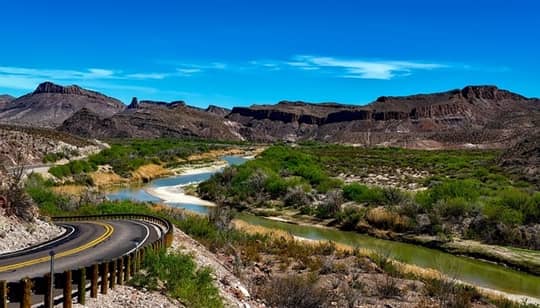All About the National Parks of Texas
There are sixty-three National Parks in the United States and more than three hundred million people visit these parks each year! Texas is home to two National Parks, Big Bend and Guadalupe Mountains. Both parks feature a wide range of landscapes and environments. They also offer a variety of activities for their visitors, including hiking and camping. Families enjoy spending time at both parks and kids will enjoy the many different activities they can participate in when they visit.

Big Bend National Park
Big Bend National Park is located near the Rio Grande in the southwestern part of Texas. The park contains more than eight hundred thousand acres. There are deserts, riverbanks, and mountains in the park.
Natural Features
The park lays across the north end of the Chihuahuan Desert. During the summer the temperature is often over 100 degrees Fahrenheit. The hot weather means many different kinds of desert plants, including ocotillo and lechuguilla, grow in the park. More types of cacti can be found in Big Bend than in any other national park located in the United States.
The Rio Grande is why Big Bend has so many deep canyons, which include the Santa Elena, Mariscal, and Boquillas canyons. The canyons consist of layers of rocks, including limestone and sandstone. Many fish live in the waters of the park, including the Big Bend gambusia.
The Chisos Mountains are in the middle of the park and are home to Emory Peak, the highest elevation in the park. It's usually about ten degrees cooler in the mountains. There are forests of oak and juniper up in the mountains.
Many different kinds of wildlife live in the various environments of the park. Bats, birds, ants, butterflies, and scorpions all live in the park. Additionally, more than 70 species of mammal live in Big Bend. They include black bears, jackrabbits, and badgers. Reptiles also live in the park, including more than 30 kinds of snakes live at the park!
Park Features
Visitors to the park enjoy hiking, mountain biking, camping, and horseback riding. Many families also enjoy driving on the over 100 miles of paved roads that run through the park. There are also large areas of parkland with no roads. These areas give hikers around 150 miles of hiking trails that let them hike through deserts, mountains, and river banks. Visitors can rent kayaks to travel through the canyons.
History
In 1933, Texas declared the area to be Texas Canyons State Park. It wasn't until 1944 that it was declared a state park and renamed as Big Bend. The park celebrates its ecological diversity but also lets visitors learn about the Native Americans who once lived on the land along with letting them find out about the early settlers to the land who moved there to be ranchers.
-
Big Bend National Park Is One of the Most Remote Places in America - Here's How to See It
-
Everything You Need to Know About Visiting Big Bend National Park
Guadalupe Mountains National Park

Western Texas has its own National Park! Guadalupe Mountains is located a little south of New Mexico in the Chihuahuan Desert. The best-known features of the park are The Capitan Reef and Guadalupe Peak, which is the highest point in all of Texas!
Natural Features
Once, the land that now makes up the Guadalupe Mountains National Park was under seawater! That was more than 260 million years ago. That sea water contained living creatures like sponges and algae. The things in seawater eventually made up the fossilized reef that today is known as Capitan Reef, which also displays the fossils of all the tiny little sea creatures that once swam in the seawater!
The park has lots of different kinds of landscapes within its borders. There are deserts, canyons, mountains, and woodlands. Thanks to these different types of ecosystems, the park has more than 1,000 species making their home in the park! Additionally, there are many different types of flora and fauna. Desert plants, like cacti and yuccas, grow throughout the park. Visitors can also expect to see bobcats, coyotes, badgers, bats, and mountain lions. The park also has many different types of reptiles.
Park Features
The park has no paved roads. However, it does have roads that go up to the mountains and allow people to get to various parts of the park. Additionally, hikers love the over 80 miles of hiking trails that range from simple walking paths to all-day hikes that take visitors to the top of Guadalupe Peak. There are also many different options for camping. Kids and adults love spotting all the different types of birds that fly through the park. At night, the clear skies let visitors gaze upon the stars in the sky.
The visitors center also functions as the park's cultural museum. It's a great place to learn about the different parts of the parks. Visitors typically like to visit the Frijole Ranch House, the Salt Basin Dunes, and the McKittrick Canyon.
History
Native Americans were the first people to inhabit the land that is now the park. Evidence of their lives, such as shards of pottery and bits of baskets, have been found all through the park. In 1869 United States troops removed the Apache who lived on the land. The Frijole Ranch was built by an early settler in 1876. During the 1920s a geologist named Wallace Pratt began purchasing acres in McKittrick Canyon. Pratt eventually donated almost 6,000 acres to the U.S. government. Eventually, the government bought about 80,000 more acres. The park officially opened in 1972.
By: Jim Olenbush
